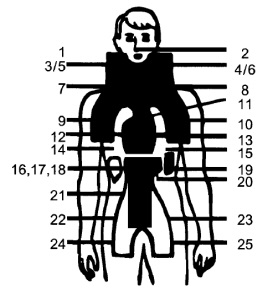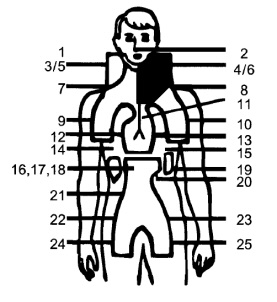Radiotherapy
Radiotherapy is a local treatment and today mostly used to supplement chemotherapy. Ideally, it destroys the complete tumor in the irradiated area without damaging the surrounding healthy tissue. But this can only be achieved if the respective tumor tissue is much more sensitive to radiation than the surrounding healthy tissue, which is the case in Hodgkin lymphoma. Technically, irradiation is achieved by energy in the megavolt range that is emitted by linear accelerators. With this technique, high doses of radiation can be applied, even to tumors in very deep layers of the body, without harming healthy tissues substantially. Radiation intensity is stated in Gray (Gy), which is the unit of the absorbed energy dose per weight volume.
In former days, radiotherapy alone (without a preceding chemotherapy) used to be the standard treatment for early stage Hodgkin lymphoma. Today, however, this approach is no longer used, except for cases with nodular lymphocyte-predominant Hodgkin lymphoma at stage IA.
Thanks to the improvements in Hodgkin lymphoma therapy, the irradiated fields have become much smaller today. In the past, so called extended fields (EF, see Figure I) that included the lymphoma and the bordering lymph node regions were irradiated.
Today only very restricted areas are irradiated after chemotherapy. This technique is called involved-field (IF) radiotherapy (see Figure II).
The figures show the radiotherapy volume compared to the involved field volume for the same patients, where the IF volume only includes the left side of the neck (high cervical, cervical, supra- and infraclavicular lymph nodes).
 |
 |
Figure I:Radiotherapy (RT) volume in a patient with stage I Hodgkin lymphoma. Left cervical involvement. (I) Typical extended-field RT volume (mantle field plus paraaortic region, spleen and splenic hilum) |
Figure II:The involved-field RT volume for the same patient only includes the complete left side of the neck (high cervical, cervical, supra- and infraclavicular lymph nodes). |
The GHSG’s standard radiation dose is 30 Gray. Radiotherapy is administered in small partial doses of 1.8–2.0 Gray per day, five times per week, so it takes 2-4 weeks to administer the full dose.
Based on the results of the HD10 trial, early stage patients without risk factors receive an involved-field radiotherapy with a total radiation dose of 20 Gray (30 Gray for intermediate stage patients). In advanced stage patients it depends on the result of the positron-emission-tomography (PET) examination whether radiotherapy will be applied or not. Residual tumors > 2.5 cm in diameter are only irradiated if the PET result is positive. All other patients do not receive radiotherapy.
In the current trials of the German Hodgkin Study Group it is being evaluated if, in certain clinical situations, involved node (IN) radiotherapy may lead to further minimization of the radiation field.